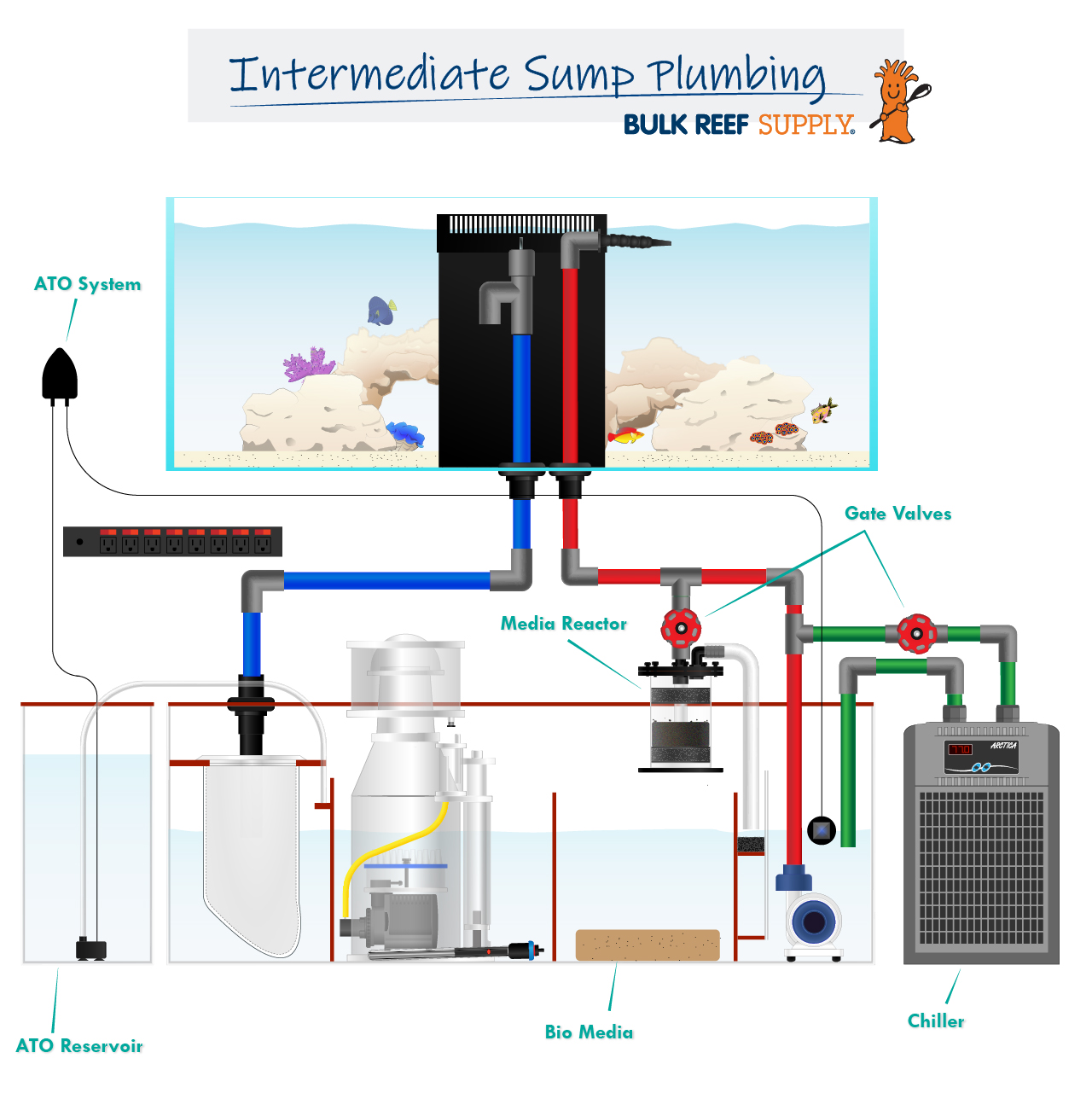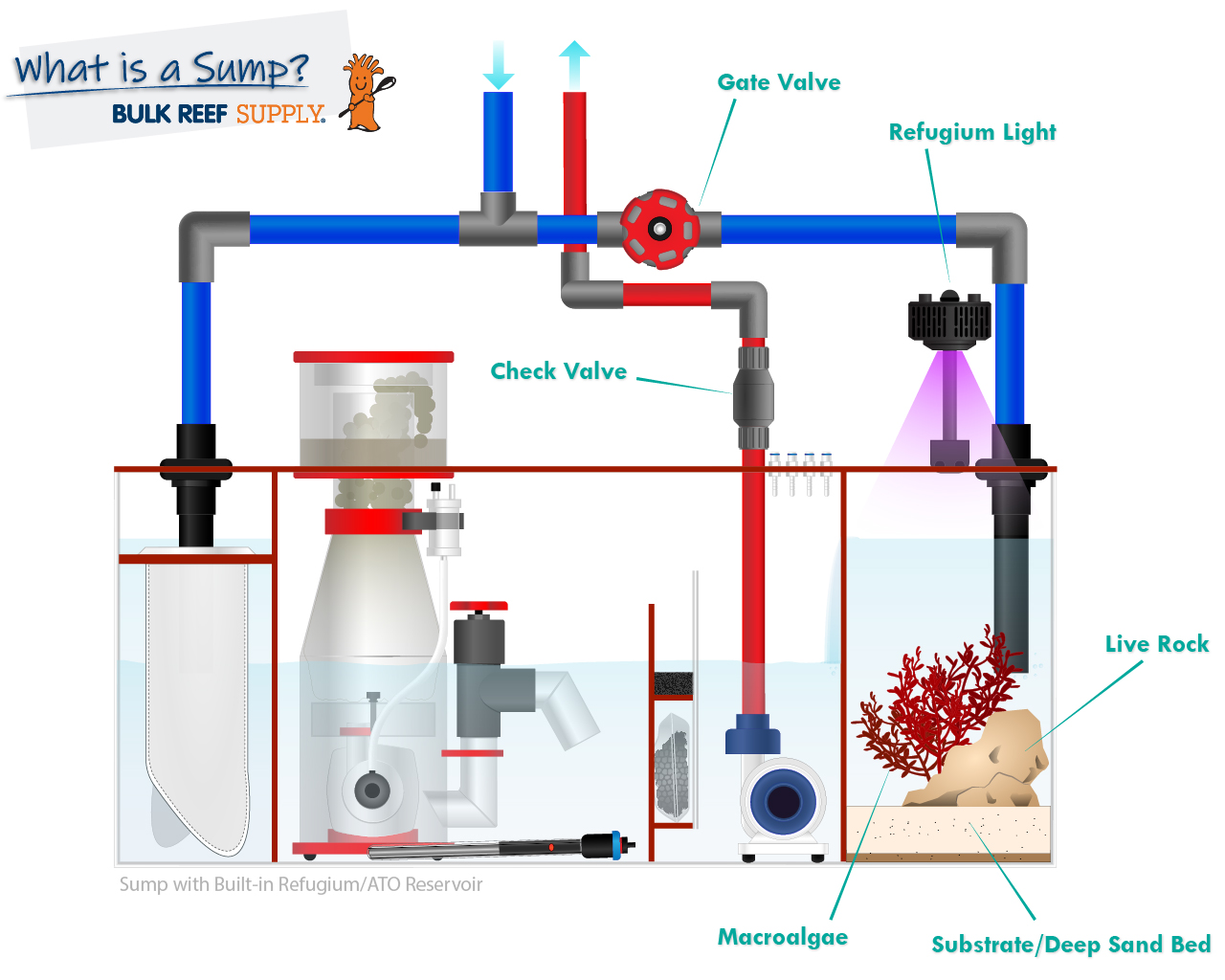Originally posted on May 19, 2023 @ 12:00 pm
Last Updated on 3 months by admin
Are you looking for a way to improve the filtration system in your aquarium? Look no further than a sump! A sump is an additional tank that can be added to your aquarium setup to increase filtration and water volume. In this article, we will guide you through the process of setting up a sump for your aquarium. By the end, you’ll have a better understanding of how a sump works and why it’s a great addition to any aquarium setup.
- Choose a sump that fits your aquarium and plumbing system.
- Install an overflow box or drill the aquarium to create an overflow.
- Connect the overflow to the sump using PVC pipes and fittings.
- Install a return pump in the sump to circulate water back to the aquarium.
- Add mechanical, chemical, and biological filters to the sump.
- Fill the sump with water and turn on the equipment.
- Monitor the system for leaks and adjust the equipment as needed.

Setting up a Sump for Your Aquarium: A Comprehensive Guide
If you’re looking to improve the filtration system in your aquarium, setting up a sump can be a great option. A sump is a separate tank that works alongside your main aquarium to filter and clean the water. It offers many benefits over other filtration methods and can help keep your aquatic creatures healthy and happy. In this article, we’ll guide you through the process of setting up a sump for your aquarium.
Step 1: Gather Your Equipment
Before you start setting up your sump, you’ll need to gather all the necessary equipment. Here’s a list of the things you’ll need:
– A sump tank
– An overflow box
– A return pump
– A heater
– A protein skimmer
– A filter sock
– Plumbing pipes and fittings
Once you have everything you need, you can start setting up your sump.
First, install the overflow box on your main aquarium. This will allow water to flow from the tank into the sump. Then, set up your sump tank and place it below your main aquarium. Connect the plumbing pipes and fittings to create a water flow between the two tanks.
Step 2: Install Your Equipment
Now that your sump is set up, it’s time to install the equipment. Start by installing the protein skimmer in the sump tank. This will help remove excess waste and debris from the water.
Next, install the filter sock. This will catch any large particles that may have made it through the overflow box. Make sure to change the filter sock regularly to keep it working effectively.
Install the heater in the sump tank to maintain a consistent water temperature. Finally, install the return pump to pump water back into the main aquarium.
Step 3: Monitor and Adjust
Once everything is set up and running, monitor the water levels and adjust the equipment as needed. Check the water temperature regularly to make sure it’s consistent. Adjust the protein skimmer and filter sock as necessary to ensure they’re working effectively.
The Benefits of Using a Sump
Using a sump as part of your aquarium filtration system offers many benefits. Here are a few:
– Increased water volume: A sump increases the overall water volume of your aquarium, which can lead to a more stable and healthy environment for your aquatic creatures.
– Improved filtration: A sump offers superior filtration compared to other methods, as it allows for more flexibility and customization.
– Reduced noise: A sump can help reduce the noise of your aquarium, as the equipment is housed in a separate tank.
Sump vs Other Filtration Methods
There are several other filtration methods you can use in your aquarium, such as canister filters or hang-on-back filters. Here’s how a sump compares:
– Capacity: A sump can hold more water and provide a larger volume for filtration compared to other methods.
– Customization: A sump allows for more customization and flexibility in filtration options.
– Noise reduction: A sump can help reduce the noise of your aquarium, while other filtration methods may be louder.
In conclusion, setting up a sump for your aquarium can be a great way to improve the overall health and well-being of your aquatic creatures. By following these simple steps and utilizing the benefits of a sump, you can create a stable and healthy environment for your fish and other aquatic creatures to thrive in.
Frequently Asked Questions
In this section, we will answer some common questions about setting up a sump for your aquarium.
What is a sump and why do I need one?
A sump is an additional tank that is connected to your main aquarium. It is typically placed underneath the main tank and is used to house equipment such as protein skimmers, heaters, and filters. The purpose of a sump is to increase the total volume of water in the system, provide additional filtration, and help maintain stable water parameters.
If you have a large aquarium or want to keep sensitive or delicate species, a sump can be a valuable addition to your setup. It can also make maintenance and cleaning easier by providing a separate area for equipment and debris.
How do I set up a sump for my aquarium?
The first step in setting up a sump is to choose a suitable tank that is large enough to house the necessary equipment and provide additional water volume. Next, you will need to install overflow boxes or bulkheads in your main tank to allow water to flow into the sump.
Once the overflow is in place, you can connect plumbing to transfer water between the main tank and sump. You will also need to install any equipment you plan to use, such as a protein skimmer, filter media, and a return pump. Finally, fill the sump with water and test the system to ensure everything is working properly.
What equipment do I need for a sump?
The equipment you need for a sump will depend on your specific setup and the size of your aquarium. Some common equipment includes a protein skimmer, filter media such as filter socks or foam blocks, a return pump to transfer water back to the main tank, and a heater to maintain stable water temperature.
You may also want to consider adding a refugium to your sump, which is a separate area that can be used to grow macroalgae or other beneficial organisms. Additionally, some aquarists choose to add a UV sterilizer to their sump to help control parasites and other harmful organisms.
How can I maintain my sump?
Maintaining your sump is an important part of keeping your aquarium healthy and thriving. Regular maintenance tasks may include cleaning filter media, checking and adjusting water levels, and performing water changes.
You should also monitor the equipment in your sump to ensure it is functioning properly and replace any worn or damaged parts as needed. It is also a good idea to regularly test your water parameters to ensure they are within the appropriate range for your fish and corals.
Can I use a sump with a freshwater aquarium?
While sumps are most commonly used with saltwater aquariums, they can also be used with freshwater setups. The benefits of a sump, such as increased water volume and additional filtration, can be just as valuable for freshwater fish and plants as they are for marine organisms.
However, the equipment you use may be different for a freshwater sump. For example, instead of a protein skimmer, you may want to use a canister filter or other type of mechanical filtration. Additionally, you will need to ensure that any additives or supplements you use are appropriate for freshwater species.

The Aquarium Sump Set Up Video 101
In conclusion, setting up a sump for your aquarium can greatly enhance the overall health and appearance of your aquatic pets. By providing additional filtration and space for equipment, a sump can create a more stable and balanced environment for your fish, plants, and invertebrates.
One important consideration when setting up a sump is choosing the right size for your aquarium. A sump that is too small may not provide adequate filtration, while a sump that is too large may be difficult to maintain or require excessive equipment.
Additionally, it is important to regularly maintain and clean your sump to ensure optimal performance. By monitoring water levels, replacing filter media, and performing routine maintenance, you can help ensure that your sump functions effectively and supports the health and well-being of your aquatic pets.
